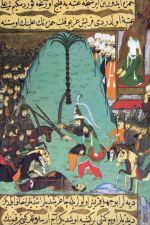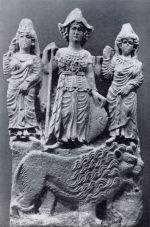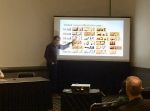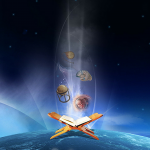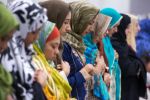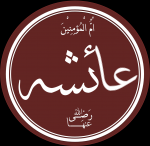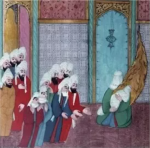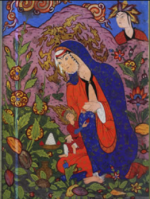Main Page: Difference between revisions
| [unchecked revision] | [unchecked revision] |
m (Updated QHS list) |
(Reworked main page to use portals) |
||
| Line 5: | Line 5: | ||
|image=Logo.square.wordmark.png | |image=Logo.square.wordmark.png | ||
|image_alt=WikiIslam Logo | |image_alt=WikiIslam Logo | ||
}} | }}{{DISPLAYTITLE:<span style="position: absolute; clip: rect(1px 1px 1px 1px); clip: rect(1px, 1px, 1px, 1px);">{{FULLPAGENAME}}</span>}} | ||
{{DISPLAYTITLE:<span style="position: absolute; clip: rect(1px 1px 1px 1px); clip: rect(1px, 1px, 1px, 1px);">{{FULLPAGENAME}}</span>}} | |||
<!-- Beginning of header section --> | <!-- Beginning of header section --> | ||
<!--No Mobile Block --> | <!--No Mobile Block --> | ||
<div class="nomobile"> | <div class="nomobile"> | ||
<div class="divTable" style="width:100%;margin-top:+.7em;background-color:#283763;border:1px solid #ccc"> | <div class="divTable" style="width:100%;margin-top:+.7em;background-color:#283763;border:1px solid #ccc"> | ||
<div class="divTableBody"> | <div class="divTableBody"> | ||
| Line 38: | Line 36: | ||
<!-- Start Left Column --> | <!-- Start Left Column --> | ||
<div class="divTableCell"> | <div class="divTableCell"> | ||
<div id="importantnote" style="width:100%;text-align:left;font-size: | <div id="importantnote" style="width:100%;text-align:left;font-size:105%;"><!--<span style="color:red">Notice:</span> --> | ||
* A number of transformative steps have been undertaken as part of an ongoing effort to improve the content, professionalism, and reliability of WikiIslam..[[WikiIslam:Renovations|read more]] | |||
* Help Wanted: [[WikiIslam: Contribute|Contribute Today]] | |||
</div> | |||
</div> | </div> | ||
</div> | </div> | ||
| Line 45: | Line 46: | ||
</div> | </div> | ||
<!-- End No Mobile Block --> | <!-- End No Mobile Block --> | ||
<!-- Start | <!-- Start the Portal Block --> | ||
*[[ | <div class="articleSummaryColumnsWrapper"> | ||
*[[ | <div class="articleSummaryColumn"> | ||
{{PortalArticle|image=Battle of Badr.jpg|title=Portal: Early Islamic History|summary=The first centuries of the Islamic Hijri calendar, starting in the CE year 622, were the formative years of the religion. Between the first and third Islamic centuries the Qur'an was written down and codified, the prophet lived and died, the great hadith collections were gathered, the sira of the prophet was committed to writing, the great schools of Sunni jurisprudence came to be, and the theology of Islam attained its familiar form. The end of the Abassid period saw the "crystallization" of the Islamic tradition around the Sunnah of the prophet and the Qur'an placed in creation before all time and space after the defeat of the Mu'atazilite heresy. These years thus can be said to cover the formation of the religion of Islam as we know it today. |description= | |||
<div style="padding: 4px;padding-left: 8px; padding-right: 8px;background: #283763; border: 1px solid #DEB330; color:#ffffff; font-size: 1.2em;">'''Sections'''</div> | |||
<div style="column-count:2;-moz-column-count:2;-webkit-column-count:2"> | |||
*[[Portal: Early Islamic History#Career of the Prophet|Career of the Prophet]] | |||
*[[Portal: Early Islamic History#The Early Caliphates|The Early Caliphates]] | |||
*[[Portal: Early Islamic History#The Formation of the Qur'an and Classical Arabic|The Formation of the Qur'an and Classical Arabic]] | |||
</div> | |||
<div style="padding: 4px;padding-left: 8px; padding-right: 8px;background: #283763; border: 1px solid #DEB330; color:#ffffff; font-size: 1.2em;">'''Popular Articles'''</div><div style="column-count:2;-moz-column-count:2;-webkit-column-count:2"> | |||
*[[Dihya the Berber Queen (Al-Kaahina)]] | |||
*[[Battle of Badr]] | |||
</div> | |||
}} | |||
{{PortalArticle|image=Daughters of Hubal.jpg|title=Portal: Origins of Islam|summary= Islam arose in 7th century Arabia, and as such its appearance bears the markings of its ancient Arab and Near East milieu. |description= | |||
<div style="padding: 4px;padding-left: 8px; padding-right: 8px;background: #283763; border: 1px solid #DEB330; color:#ffffff; font-size: 1.2em;">'''Sections'''</div> | |||
<div style="column-count:2;-moz-column-count:2;-webkit-column-count:2"> | |||
*[[Portal: Origins of Islam#Arab Paganism|Arab Paganism]] | |||
*[[Portal: Origins of Islam#The Formation of the Qur'an and Classical Arabic|The Formation of the Qur'an and Classical Arabic]] | |||
*[[Portal: Origins of Islam#Ancient Arabian Culture|Ancient Arabian Culture]] | |||
</div> | |||
<div style="padding: 4px;padding-left: 8px; padding-right: 8px;background: #283763; border: 1px solid #DEB330; color:#ffffff; font-size: 1.2em;">'''Popular Articles'''</div><div style="column-count:2;-moz-column-count:2;-webkit-column-count:2"> | |||
*[[Textual History of the Qur'an]] | |||
*[[Sana'a Manuscript]] | |||
*[[Seven Sleepers of Ephesus in the Quran]] | |||
*[[Dhul-Qarnayn and the Alexander Romance]] | |||
</div>}}{{PortalArticle|image=Islamic Tradition.jpg|title=Portal: Qur'an, Hadith, and Scholars|summary= The Qur'an, Hadith, Scripture pages are a special category of pages here at WikiIslam. Rather than being encyclopedia articles, these pages bring together a unique collection Quranic verses, hadith, sira traditions, tafsir, writings of classical scholars and futuwa of contemporary Islamic sheikhs and ulemaa. The pages are organized by theme to assist the student, searcher or researcher. |description= | |||
<div style="padding: 4px;padding-left: 8px; padding-right: 8px;background: #283763; border: 1px solid #DEB330; color:#ffffff; font-size: 1.2em;">'''Sections'''</div> | |||
<div style="column-count:2;-moz-column-count:2;-webkit-column-count:2"> | |||
*[[Portal: Qur'an, Hadith, and Scholars#The Islamic Tradition Itself|The Islamic Tradition]] | |||
*[[Portal: Qur'an, Hadith, and Scholars#Muhammad|Muhammad]] | |||
*[[Portal: Qur'an, Hadith, and Scholars#Women|Women]] | |||
*[[Portal: Qur'an, Hadith, and Scholars#Jihad|Jihad]] | |||
*[[Portal: Qur'an, Hadith, and Scholars#Non-Muslims|Non-Muslims]] | |||
*[[Portal: Qur'an, Hadith, and Scholars#Miscellaneous|Miscellaneous]] | |||
</div> | |||
<div style="padding: 4px;padding-left: 8px; padding-right: 8px;background: #283763; border: 1px solid #DEB330; color:#ffffff; font-size: 1.2em;">'''Popular Articles'''</div><div style="column-count:2;-moz-column-count:2;-webkit-column-count:2"> | |||
*[[Qur'an, Hadith and Scholars:Textual History of the Qur'an|Textual History of the Qur'an]] | |||
*[[Qur'an, Hadith and Scholars:Apostasy|Apostasy]] | |||
*[[Qur'an, Hadith and Scholars:Homosexuality|Homosexuality]] | |||
*[[Qur'an, Hadith and Scholars:Stoning|Stoning]] | |||
</div>}} | |||
{{PortalArticle|image=Quran_Mashaf_Comparisons.jpg|title=Portal: Islamic Scriptures|summary=The idea of scripture is central to Islam; above all else, Islam's own scriptures tell of how Allah has periodically given his followers books throughout the ages, and refers to Islam's co-abrahamic religionists as People of the Book. The central scripture of Islam is above all the Qur'an, which orthodox Sunni and Shi'i Islam see as the literal word of Allah through his messenger Muhammad. |description= | |||
<div style="padding: 4px;padding-left: 8px; padding-right: 8px;background: #283763; border: 1px solid #DEB330; color:#ffffff; font-size: 1.2em;">'''Sections'''</div> | |||
<div style="column-count:2;-moz-column-count:2;-webkit-column-count:2"> | |||
*[[Portal: Islamic Scriptures#Qur'an|Qur'an]] | |||
*[[Portal: Islamic Scriptures#Hadith|Hadith]] | |||
*[[Portal: Islamic Scriptures#Sira|Sira]] | |||
*[[Portal: Islamic Scriptures#Tafsir|Tafsir]] | |||
</div> | |||
<div style="padding: 4px;padding-left: 8px; padding-right: 8px;background: #283763; border: 1px solid #DEB330; color:#ffffff; font-size: 1.2em;">'''Popular Articles'''</div><div style="column-count:2;-moz-column-count:2;-webkit-column-count:2"> | |||
*[[Naskh (Abrogation)]] | *[[Naskh (Abrogation)]] | ||
*[[ | *[[Sahih Bukhari]] | ||
*[[ | </div> | ||
*[[ | }} | ||
*[[ | {{PortalArticle|image=Fiqh.jpeg|title=Portal: Islamic Law|summary=There is much in Islamic scripture that is not of direct legal relevance and which can be understood as constituting doctrine. The Arabic word aqeedah, or creed, has generally been understood to encompass a more limited range of ideas than what, to a modern person, would appear as Islamic doctrine. |description= | ||
*[[ | <div style="padding: 4px;padding-left: 8px; padding-right: 8px;background: #283763; border: 1px solid #DEB330; color:#ffffff; font-size: 1.2em;">'''Sections'''</div> | ||
<div style="column-count:2;-moz-column-count:2;-webkit-column-count:2"> | |||
*[[Portal: Islamic Law#Theory|Theory]] | |||
*[[Portal: Islamic Law#Women|Women]] | |||
*[[Portal: Islamic Law#Non-Muslims|Non-Muslims]] | |||
*[[Portal: Islamic Law#Crime and punishment|Crime and punishment]] | |||
*[[Portal: Islamic Law#Jihad|Jihad]] | |||
*[[Portal: Islamic Law#Ritual|Ritual]] | |||
*[[Portal: Islamic Law#Other topics in Islamic law|Other topics in Islamic law]] | |||
</div> | |||
<div style="padding: 4px;padding-left: 8px; padding-right: 8px;background: #283763; border: 1px solid #DEB330; color:#ffffff; font-size: 1.2em;">'''Popular Articles'''</div><div style="column-count:2;-moz-column-count:2;-webkit-column-count:2"> | |||
*[[Taqiyya]] | |||
*[[Qurban (Ritual Sacrifice)]] | |||
*[[Fiqh (Islamic Jurisprudence)]] | |||
*[[If Anyone Slays a Person (Qur'an 5:32)]] | |||
*[[Relationships with non-Muslims in Islamic Law]] | |||
*[[Shari'ah (Islamic Law)]] | |||
</div> | |||
}} | |||
{{PortalArticle|image=Tawheed.jpg|title=Portal: Islamic Doctrine|summary=There is much in Islamic scripture that is not of direct legal relevance and which can be understood as constituting doctrine. The Arabic word aqeedah, or creed, has generally been understood to encompass a more limited range of ideas than what, to a modern person, would appear as Islamic doctrine. |description= | |||
<div style="padding: 4px;padding-left: 8px; padding-right: 8px;background: #283763; border: 1px solid #DEB330; color:#ffffff; font-size: 1.2em;">'''Sections'''</div> | |||
<div style="column-count:2;-moz-column-count:2;-webkit-column-count:2"> | |||
*[[Portal: Islamic Doctrine#God|God]] | |||
*[[Portal: Islamic Doctrine#Other beings|Other beings]] | |||
*[[Portal: Islamic Doctrine#Earthly places and relics|Earthly places and relics]] | |||
*[[Portal: Islamic Doctrine#Past and future events|Past and future events]] | |||
*[[Portal: Islamic Doctrine#Society and human nature|Society and human nature]] | |||
</div> | |||
<div style="padding: 4px;padding-left: 8px; padding-right: 8px;background: #283763; border: 1px solid #DEB330; color:#ffffff; font-size: 1.2em;">'''Popular Articles'''</div><div style="column-count:2;-moz-column-count:2;-webkit-column-count:2"> | |||
*[[Tawheed]] | |||
*[[Let There be no Compulsion in Religion|Let There be no Compulsion in Religion (Qur'an 2:256)]] | |||
*[[Jinn]] | |||
*[[Black Stone]] | |||
</div> | |||
}} | |||
</div><div class="articleSummaryColumn"> | |||
{{PortalArticle|image=Quran and Science.png|title=Portal: Islam and Science|summary=Among the many and diverse matters discussed in or touched upon by Islamic scriptures are topics of direct or indirect scientific interest. These topics include reproductive science, embryology, cosmology, and medicine, among others. |description= | |||
<div style="padding: 4px;padding-left: 8px; padding-right: 8px;background: #283763; border: 1px solid #DEB330; color:#ffffff; font-size: 1.2em;">'''Sections'''</div> | |||
<div style="column-count:2;-moz-column-count:2;-webkit-column-count:2"> | |||
*[[Portal: Islam and Science#Biology|Biology]] | |||
*[[Portal: Islam and Science#Cosmology|Cosmology]] | |||
*[[Portal: Islam and Science#Islamic practices and rituals|Islamic practices and rituals]] | |||
*[[Portal: Islam and Science#Prominent figures and movements|Prominent figures and movements]] | |||
</div> | |||
<div style="padding: 4px;padding-left: 8px; padding-right: 8px;background: #283763; border: 1px solid #DEB330; color:#ffffff; font-size: 1.2em;">'''Popular Articles'''</div><div style="column-count:2;-moz-column-count:2;-webkit-column-count:2"> | |||
*[[Scientific Errors in the Quran]] | *[[Scientific Errors in the Quran]] | ||
*[[Cosmology of the Quran | *[[Cosmology of the Quran]] | ||
*[[Geocentrism and the Quran | *[[Geocentrism and the Quran]] | ||
*[[Embryology in the Qur'an]] | |||
*[[ | </div> | ||
}} {{PortalArticle|image=Muslim-usa.jpg|title=Portal: Islam and Human Rights|summary=Among the many and diverse matters discussed in or touched upon by Islamic scriptures are topics of direct or indirect scientific interest. These topics include reproductive science, embryology, cosmology, and medicine, among others. |description= | |||
*[[ | <div style="padding: 4px;padding-left: 8px; padding-right: 8px;background: #283763; border: 1px solid #DEB330; color:#ffffff; font-size: 1.2em;">'''Sections'''</div> | ||
*[[ | <div style="column-count:2;-moz-column-count:2;-webkit-column-count:2"> | ||
*[[ | *[[Portal: Islam and Human Rights#Women|Women]] | ||
*[[ | *[[Portal: Islam and Human Rights#Religious Minorities|Religious Minorities]] | ||
*[[Portal: Islam and Human Rights#Freedom of Conscience|Freedom of Conscience]] | |||
*[[Portal: Islam and Human Rights#Corporal punishment|Corporal punishment]] | |||
*[[Portal: Islam and Human Rights#Modern movements and events|Modern movements and events]]</div> | |||
<div style="padding: 4px;padding-left: 8px; padding-right: 8px;background: #283763; border: 1px solid #DEB330; color:#ffffff; font-size: 1.2em;">'''Popular Articles'''</div><div style="column-count:2;-moz-column-count:2;-webkit-column-count:2"> | |||
*[[Hijab#Revelation_of_the_Hijab_Verses|Revelation of the Hijab Verses]] | |||
*[[Wife Beating in Islamic Law]] | |||
*[[Islam and Homosexuality]] | |||
*[[The Rushdie Affair]]</div>}} | |||
{{PortalArticle|image=Maome.jpeg|title=Portal: Muhammad|summary=Muhammad, the founder of Islam, is one of the most vigorously revered men to have ever lived. His legacy has meant many different things to many different people throughout history. Information on his life comes almost exclusively through oral reports (hadiths) compiled, for the most part, more than a hundred and fifty years after his death. While historians span a spectrum of skepticism regarding the reliability of these frequently hagiographic and tendentious writings, Islamic scholars have and continue to rely on some portion of the hadith which they consider to be authentic (sahih) in order to formulate most of Islamic doctrine, ritual, and law. Consequently, while some contend that Muhammad is altogether enigmatic as a historical entity, the accounts of his life found in Islamic scriptures have found near-universal assent in the Muslim world and comprise a fundamental part of the Islamic self-identity. |description= | |||
<div style="padding: 4px;padding-left: 8px; padding-right: 8px;background: #283763; border: 1px solid #DEB330; color:#ffffff; font-size: 1.2em;">'''Sections'''</div> | |||
<div style="column-count:2;-moz-column-count:2;-webkit-column-count:2"> | |||
*[[Portal: Muhammad#Personal life|Personal life]] | |||
*[[Portal: Muhammad#Military life|Military life]] | |||
*[[Portal: Muhammad#Religious life|Religious life]] | |||
*[[Portal: Muhammad#In doctrine|In doctrine]] | |||
*[[Portal: Muhammad#In history|In history]] | |||
*[[Portal: Muhammad#In recent times|In recent times]] | |||
</div> | |||
<div style="padding: 4px;padding-left: 8px; padding-right: 8px;background: #283763; border: 1px solid #DEB330; color:#ffffff; font-size: 1.2em;">'''Popular Articles'''</div><div style="column-count:2;-moz-column-count:2;-webkit-column-count:2"> | |||
*[[Muhammad ibn Abdullah]] | *[[Muhammad ibn Abdullah]] | ||
*[[ | *[[Muhammads Miracles]] | ||
*[[List of Killings Ordered or Supported by Muhammad]] | *[[List of Killings Ordered or Supported by Muhammad]] | ||
*[[ | *[[Farewell Sermon]] | ||
</div> | |||
}} | |||
*[[ | {{PortalArticle|image=Aisha.png|title=Portal: Muhammad’s Wives and Consorts|summary=The wives of the prophet are described as "أمهات المؤمنين" or "mothers of the believers." As such the prophetic example is considered instructive for all Muslim households. How the prophet interacted with his wives, and how they obeyed him, is a framework for how Muslim husbands and wives ought to interact, as well as how men should interact with their own female slaves. |description= | ||
*[[Muhammad's | <div style="padding: 4px;padding-left: 8px; padding-right: 8px;background: #283763; border: 1px solid #DEB330; color:#ffffff; font-size: 1.2em;">'''Sections'''</div> | ||
<div style="column-count:2;-moz-column-count:2;-webkit-column-count:2"> | |||
*[[Portal: Muhammad’s Wives and Consorts#Aisha|Aisha]] | |||
*[[Portal: Muhammad’s Wives and Consorts#Muhammad's Other Wives and Consorts|Muhammad's Other Wives and Consorts]] | |||
</div> | |||
<div style="padding: 4px;padding-left: 8px; padding-right: 8px;background: #283763; border: 1px solid #DEB330; color:#ffffff; font-size: 1.2em;">'''Popular Articles'''</div><div style="column-count:2;-moz-column-count:2;-webkit-column-count:2"> | |||
*[[Ages of Muhammads Wives at Marriage|Ages of Muhammad's Wives at Marriage]] | *[[Ages of Muhammads Wives at Marriage|Ages of Muhammad's Wives at Marriage]] | ||
*[[Aisha | *[[Aisha]] | ||
*[[Safiyah]] | *[[Safiyah]] | ||
</div> | |||
}} | |||
{{PortalArticle|image=Sahabah.png|title=Portal: Muhammad's Companions and Contemporaries|summary=Muhammad's contemporaries, companions, and successors play an elevated role in the lore of Islam. It is against many of his contemporaries that Muhammad defined his movement, it is through his companions that his tradition was passed forth, and it is by his immediate successors that his legacy was interpreted and formalized. |description= | |||
<div style="padding: 4px;padding-left: 8px; padding-right: 8px;background: #283763; border: 1px solid #DEB330; color:#ffffff; font-size: 1.2em;">'''Sections'''</div> | |||
<div style="column-count:2;-moz-column-count:2;-webkit-column-count:2"> | |||
*[[Portal: Muhammad's Companions and Contemporaries#Male companions|Male companions]] | |||
*[[Portal: Muhammad's Companions and Contemporaries#Female companions|Female companions]] | |||
*[[Portal: Muhammad's Companions and Contemporaries#Opponents|Opponents]] | |||
*[[Portal: Muhammad's Companions and Contemporaries#Others|Others]] | |||
*[[ | |||
*[[ | |||
*[[ | |||
*[[ | |||
</div> | |||
<div style="padding: 4px;padding-left: 8px; padding-right: 8px;background: #283763; border: 1px solid #DEB330; color:#ffffff; font-size: 1.2em;">'''Popular Articles'''</div><div style="column-count:2;-moz-column-count:2;-webkit-column-count:2"> | |||
*[[Khadijah bint Khuwaylid]] | |||
*[[Abu Bakr Abdullah ibn Uthman]] | |||
*[[ | |||
*[[Ali ibn Abi Talib]] | *[[Ali ibn Abi Talib]] | ||
*[[ | *[[Abu Lahab]] | ||
</div> | |||
}} | |||
{{PortalArticle|image=Mary In the Quran.PNG|title=Portal: Islam and the Judeo-Christian Tradition|summary=The Qur'an makes constant reference to the stories of the Judeao-Christian tradition. The references are familiar and sometimes in passing, and assume a great deal of familiarity on the part of the listeners. The audience for these chapters was clearly one well-acquainted with the stories themselves and the Qur'an itself says that it is a "reminder" (73:19) of the message which has come before |description= | |||
<div style="padding: 4px;padding-left: 8px; padding-right: 8px;background: #283763; border: 1px solid #DEB330; color:#ffffff; font-size: 1.2em;">'''Sections'''</div> | |||
<div style="column-count:2;-moz-column-count:2;-webkit-column-count:2"> | |||
*[[Portal: Islam and the Judeo-Christian Tradition#Islam and the Hebrew Bible Tradition|Islam and the Hebrew Bible Tradition]] | |||
*[[Portal: Islam and the Judeo-Christian Tradition#Islam and the Christian Scriptural Tradition|Islam and the Christian Scriptural Tradition]] | |||
*[[Portal: Islam and the Judeo-Christian Tradition#Islam and extra-biblical Stories from the Jewish and Christian Traditions|Islam and extra-biblical Stories from the Jewish and Christian Traditions]] | |||
</div> | |||
*[[ | <div style="padding: 4px;padding-left: 8px; padding-right: 8px;background: #283763; border: 1px solid #DEB330; color:#ffffff; font-size: 1.2em;">'''Popular Articles'''</div><div style="column-count:2;-moz-column-count:2;-webkit-column-count:2"> | ||
*[[ | *[[Mary, Sister of Aaron]] | ||
*[[ | *[[Virgin Conception of Jesus in the Qur'an]] | ||
*[[ | |||
*[[ | |||
*[[Dhul-Qarnayn and the Alexander Romance]] | *[[Dhul-Qarnayn and the Alexander Romance]] | ||
*[[Lut]] | |||
</div> | |||
}} | |||
</div> | |||
</div> | |||
<!-- End The Portal Block --> | |||
<!-- Start | <div class="divTable" style="border-spacing: 4px;"> | ||
<div class="divTableCell" style=" | <div class="divTableBody"> | ||
<div class="divTableRow"> | |||
<!-- Start Left Column --> | |||
<div class="divTableCell" style="background: #FAF4E1; border: 1px solid #DEB330;"> | |||
<div class="divTable"> | <div class="divTable"> | ||
<div class="divTableBody"> | <div class="divTableBody"> | ||
<!-- Start Qur'an --> | |||
<div class="divTableRow"> | <div class="divTableRow"> | ||
<div class=" | <div class="divTableHead"> | ||
<div style="margin: 0; background: # | <div style="margin: 0; background: #DEB330; font-size: 120%; font-weight: bold; border: 1px solid #a3bfb1; text-align: left; color: #fff; padding: 0.2em 0.4em;">Featured Articles</div> | ||
</div> | </div> | ||
</div> | </div> | ||
| Line 222: | Line 257: | ||
*[[Zakat (Tax)]] | *[[Zakat (Tax)]] | ||
*[[Taqiyya]] | *[[Taqiyya]] | ||
</div> | </div> | ||
</div> | </div> | ||
</div> | |||
</div> | |||
</div> | |||
<!-- Start of right-column --> | |||
<div class="divTableCell" style="margin: 10px;background: #EAEBF0; border: 1px solid #cedff2;"> | |||
<div class="divTable"> | |||
<div class="divTableBody"> | |||
<!-- About WikiIslam --> | <!-- About WikiIslam --> | ||
<div class="divTableRow"> | <div class="divTableRow"> | ||
| Line 281: | Line 294: | ||
</div> | </div> | ||
</div> | </div> | ||
</div> | </div> | ||
</div> | </div> | ||
| Line 300: | Line 300: | ||
</div> | </div> | ||
</div> | </div> | ||
<!-- Random Image --> | <!-- Random Image --> | ||
{{Template:Pictorial-Islam-options}} | {{Template:Pictorial-Islam-options}} | ||
__NOTOC____NOTITLE__ | __NOTOC____NOTITLE__ | ||
Revision as of 00:43, 25 February 2021
- A number of transformative steps have been undertaken as part of an ongoing effort to improve the content, professionalism, and reliability of WikiIslam..read more
- Help Wanted: Contribute Today
The first centuries of the Islamic Hijri calendar, starting in the CE year 622, were the formative years of the religion. Between the first and third Islamic centuries the Qur'an was written down and codified, the prophet lived and died, the great hadith collections were gathered, the sira of the prophet was committed to writing, the great schools of Sunni jurisprudence came to be, and the theology of Islam attained its familiar form. The end of the Abassid period saw the "crystallization" of the Islamic tradition around the Sunnah of the prophet and the Qur'an placed in creation before all time and space after the defeat of the Mu'atazilite heresy. These years thus can be said to cover the formation of the religion of Islam as we know it today.
Islam arose in 7th century Arabia, and as such its appearance bears the markings of its ancient Arab and Near East milieu.
The Qur'an, Hadith, Scripture pages are a special category of pages here at WikiIslam. Rather than being encyclopedia articles, these pages bring together a unique collection Quranic verses, hadith, sira traditions, tafsir, writings of classical scholars and futuwa of contemporary Islamic sheikhs and ulemaa. The pages are organized by theme to assist the student, searcher or researcher.
The idea of scripture is central to Islam; above all else, Islam's own scriptures tell of how Allah has periodically given his followers books throughout the ages, and refers to Islam's co-abrahamic religionists as People of the Book. The central scripture of Islam is above all the Qur'an, which orthodox Sunni and Shi'i Islam see as the literal word of Allah through his messenger Muhammad.
There is much in Islamic scripture that is not of direct legal relevance and which can be understood as constituting doctrine. The Arabic word aqeedah, or creed, has generally been understood to encompass a more limited range of ideas than what, to a modern person, would appear as Islamic doctrine.
There is much in Islamic scripture that is not of direct legal relevance and which can be understood as constituting doctrine. The Arabic word aqeedah, or creed, has generally been understood to encompass a more limited range of ideas than what, to a modern person, would appear as Islamic doctrine.
Among the many and diverse matters discussed in or touched upon by Islamic scriptures are topics of direct or indirect scientific interest. These topics include reproductive science, embryology, cosmology, and medicine, among others.
Among the many and diverse matters discussed in or touched upon by Islamic scriptures are topics of direct or indirect scientific interest. These topics include reproductive science, embryology, cosmology, and medicine, among others.
Muhammad, the founder of Islam, is one of the most vigorously revered men to have ever lived. His legacy has meant many different things to many different people throughout history. Information on his life comes almost exclusively through oral reports (hadiths) compiled, for the most part, more than a hundred and fifty years after his death. While historians span a spectrum of skepticism regarding the reliability of these frequently hagiographic and tendentious writings, Islamic scholars have and continue to rely on some portion of the hadith which they consider to be authentic (sahih) in order to formulate most of Islamic doctrine, ritual, and law. Consequently, while some contend that Muhammad is altogether enigmatic as a historical entity, the accounts of his life found in Islamic scriptures have found near-universal assent in the Muslim world and comprise a fundamental part of the Islamic self-identity.
The wives of the prophet are described as "أمهات المؤمنين" or "mothers of the believers." As such the prophetic example is considered instructive for all Muslim households. How the prophet interacted with his wives, and how they obeyed him, is a framework for how Muslim husbands and wives ought to interact, as well as how men should interact with their own female slaves.
Muhammad's contemporaries, companions, and successors play an elevated role in the lore of Islam. It is against many of his contemporaries that Muhammad defined his movement, it is through his companions that his tradition was passed forth, and it is by his immediate successors that his legacy was interpreted and formalized.
The Qur'an makes constant reference to the stories of the Judeao-Christian tradition. The references are familiar and sometimes in passing, and assume a great deal of familiarity on the part of the listeners. The audience for these chapters was clearly one well-acquainted with the stories themselves and the Qur'an itself says that it is a "reminder" (73:19) of the message which has come before
|
